THE MÖBIUS BAND AND
THE PROJECTIVE PLANE
(Page 2 of 2)
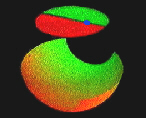
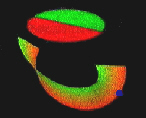 We gradually
deform the remainder so that it becomes more like a strip. Now we can glue
together those parts of this strip which should have have been glued as part
of the hemisphere.
We gradually
deform the remainder so that it becomes more like a strip. Now we can glue
together those parts of this strip which should have have been glued as part
of the hemisphere.
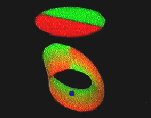 So there has to be a twist as we glue,
and we get the famous Möbius Band. We have replaced our original picture
of a moving pivoted rod in 3-dimensional space by a point (or disc) moving
on a space which consists of a Möbius Band and a disc.
So there has to be a twist as we glue,
and we get the famous Möbius Band. We have replaced our original picture
of a moving pivoted rod in 3-dimensional space by a point (or disc) moving
on a space which consists of a Möbius Band and a disc.
The edges of the disc and the Möbius Band are circles, and these circular
edges are to be thought of as glued together. Again, we cannot do this gluing
or sewing in our real three dimensional space, but we illustrate it by showing
our moving disc hopping instantaneously from the edge of the Möbius
Band to the disc, and back again.
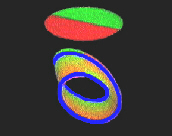 This picture of our mathematical space
is convenient for representing types of motion of our pivoted rod. The moving
disc now leaves a trail, which joins up to form what we call a loop. This
loop represents a regular and repetitive motion of the original rod.
This picture of our mathematical space
is convenient for representing types of motion of our pivoted rod. The moving
disc now leaves a trail, which joins up to form what we call a loop. This
loop represents a regular and repetitive motion of the original rod.
Now we can deform the loop to show different motions.
| The loop expands off the Möbius Band, |
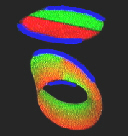 |
| onto the disc, |
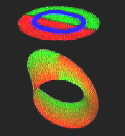 |
| and finally down to a point. This point corresponds to a stationary rod. |
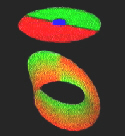 |
The movement of this loop shows how our two parts of the space are joined.
It also shows us the advantages of the new picture: the changes of types
of motion are more easily represented in our new model than in our original
picture. Our new model allows for a global picture of particular motions
of the rod in 3-dimensional space.
Another important aspect is that the movements of this loop not only describe
different motions, but also give us information on the mathematical space
which represents the positions of the rod. We are interested not only in
movements, but in movements of movements, and so on, and this is an intimation
of a higher dimensional theory, of which there is much still to be understood.
Aa part of our sequence of pictures, we have a loop which goes twice round
the Möbius Band, and then this loop is deformed off the band and over
to the disc, and then to a small loop, and finally to a point, which represents
a stationary rod. This is related to the famous
Dirac String
Trick.
Mathematicians need to progress to the representation of more complicated
situations, which arise in applications. The approach through studying `phase
space', that is the space representing all possible positions, has proved
very useful. Good visualisation of the simple examples is important for using
analogy to study the wider examples. We also need some general methods. The
notion of fibre bundle has proved a convenient
tool for representing many complicated spaces.
The stills on this page are taken from the video "
Pivoted lines and the Möbius Band". We would like to thank Len
Brown for producing the stills from the video.
THE MATHEMATICAL THEMES
-
Borromean Rings - what
they are and why they don't exist!
-
The Möbius Band - what
one looks like, experiments to try, and a beautiful rotating golden one enabling
you to really see what one looks like in 3D (this is optional as 90Kb).
-
Bernard Morin and the Brehm Model
- how Bernard Morin showed John Robinson the Brehm Model of the
Möbius Band and how to make one!
-
Fibre Bundles - what
they are, how to make them, and examples of them in John Robinson's Work.
-
Knots and Links -
Introduction to the subject of Knot Theory, includes history of the subject,
and a rotating mathematically constructed Immortality (the trefoil being
one of the most basic knots).
-
Torus Knots - two pages
explaining the basics about torus knots with the help of excellent colourful
graphics. There are also 3D moving images of John Robinson's sculptures of
the Gordian Knot and the Rhythm of Life.
-
Fractals 3 pages, introducing
Fractals, considering iteration, The Sierpinski Gasket and the applications
of the subject.
-
Exhibition
"Mathematics and Knots"
-
Ronnie
Brown's Homepage
-
John Robinson's Symbolic
Sculpture
-
Brochure giving a guided
Tour around the Symbolic Sculptures at the University of Wales, Bangor.
-
About the Centre for the Popularisation
of Mathematics
©Mathematics and
Knots/Edition Limitee 1996
This material may be used freely for educational, artistic and scientific
purposes, but may not be used for commercial purposes, for profit or in texts
without the permission of the publishers.
Last modified 29 November, 1997.

 We gradually
deform the remainder so that it becomes more like a strip. Now we can glue
together those parts of this strip which should have have been glued as part
of the hemisphere.
We gradually
deform the remainder so that it becomes more like a strip. Now we can glue
together those parts of this strip which should have have been glued as part
of the hemisphere.
 So there has to be a twist as we glue,
and we get the famous Möbius Band. We have replaced our original picture
of a moving pivoted rod in 3-dimensional space by a point (or disc) moving
on a space which consists of a Möbius Band and a disc.
So there has to be a twist as we glue,
and we get the famous Möbius Band. We have replaced our original picture
of a moving pivoted rod in 3-dimensional space by a point (or disc) moving
on a space which consists of a Möbius Band and a disc.
 This picture of our mathematical space
is convenient for representing types of motion of our pivoted rod. The moving
disc now leaves a trail, which joins up to form what we call a loop. This
loop represents a regular and repetitive motion of the original rod.
This picture of our mathematical space
is convenient for representing types of motion of our pivoted rod. The moving
disc now leaves a trail, which joins up to form what we call a loop. This
loop represents a regular and repetitive motion of the original rod.


